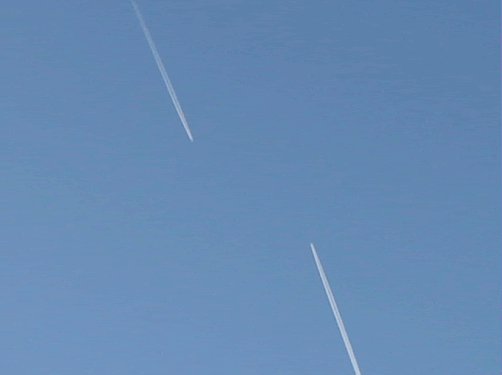One of the recurring contentions of the chemtrailers on this thread is that Monsanto is spraying aluminum in order to increase aluminum levels in the soil so they can sell aluminum resistant seeds. Aluminum content already in the soil aside, can anyone explain to me, if this is the case, why they are wasting resources ‘spraying’ over heavily populated urban areas and leaving the rural agricultural areas where the maximum return on investment for them is largely untouched? The idea of on target application from altitudes of 25,000+ feet is laughable enough to dismiss the subject out of hand without further thought anyway, but just wondered if anyone had an explanation for the majority of the spraying happening over urban non-agricultural areas. I live in an area that is dominated by Monsanto products, yet I see chem/contrails very rarely around here. Seems to me they are missing their market, so to speak. Secondly, and far more importantly, I am unaware of an aircraft that could carry the volume of material required to make a chemtrail for miles upon miles, along with the massive pump system needed to put it out. Consider that these aircraft are observed for miles upon end, putting out a constant, dense stream of chemicals, never needing to land to re-load. Well, consider this. Let’s take a 747-81, one of the largest aircraft in service, civilian or military. It has an empty operating weight of 472,900 lbs. (aircraft plus all fluids, crew, required equipment and unusable fuel), and a max takeoff weight of 975,000 lbs. This leaves 502,100 lbs for fuel and payload. Let’s just go with 2 hours of fuel. Jet fuel weighs 6.8 lbs/gal. Fuel burn is 3,855 gal/hr @cruise altitude of 35,000 ft. (Max range at MTOW = 9,200 miles. Max fuel = 62,225 gal. Cruise speed @35,000 ft = 570 mph. 9,200 miles / 570 mph = 16.14 hrs. 62,225 gal/16.14 hrs = 3,855 gals/hr @cruise). 3,855 x 6.8 lbs/gal x 2 hrs = 52,428 lbs. 502,100 – 52,428 = 449,672 lbs available for payload. This allows for a hypothetical unpowered ascent and descent that burns 0 fuel. Water is 8.34 lbs per gallon, and aluminum is 2.7 times denser than water. Let’s use the weight of just water, as the total quantity of aluminum is unknown. We will even assume weightless containers and pump systems for this exercise. 449,672 lbs / 8.34 lbs/gallon = 53,917 gals/H2O. During a 2 hour flight, at even flow, the aircraft would be putting out a rate of 7.49 gal/sec. A 747 travelling at cruise speed of 570 mph will be moving at 836 ft/sec. It has a wingspan of 224 ft. The span of chem/contrails is generally regarded to be slightly more than the wingspan of the jets observed in flight. For simplicity, we will lower it to just the wingspan. In one second it will travel 846 ft x 224 ft wingspan = total area of 189,504 sq/ft covered. 189,504/43,560 = 4.35 acres covered in 1 second. 7.49 gal/sec / 4.35 acres/sec = 1.72 gal/acre. An acre, for scale, is about the size of an American football field, sideline to sideline, and just slightly less than goal line to goal line. 2 gallons of water over a football field. I can tell you for a fact that 2 gallons per acre is virtually impossible to see coming out of the nozzles of an AT-502 when parked on the road next to the field he is working, much less from 6 miles away. And what is seen in the skies regarding these trails is clearly more than that. SUBSTANTIALLY more than that. So how do you get more into the airplane? The answer is, you can’t. You could shorten the flight, but let’s say that we reduced the flight to 15 minutes. All we have done is increased the output to 13.76 gallons/acre. Ground sprayers commonly put out 20 gallons/acre, and looks nothing like the volume seen behind an aircraft at high altitude. Still would not be visible from 6 miles down, much less linger in the skies for hours. To get the types of volume that can be seen lingering for hours we are probably talking about a MINIMUM rate of 300 gallons per acre, per second breaking up in the airstream to create that cloud at the very, very least. Ok, that means that the aircraft is now putting out 1,305 gal/sec of total volume. At that rate, the aircraft would be out of spray in 41 seconds, leaving a trail only 6.6 miles long. Remember, this is working the problem using just water. Aluminum is 2.7 times denser, lowering total volume available as it is added to the equation. Given my working knowledge in the aerial spraying business, I am convinced that to leave the visible, voluminous trails that are seen by chemtrailers, that it would take significantly more than 1,305 gallons/sec in this example to create that effect. But, even at 1,305 gallons, there is also the issue of 10,883 lbs of water leaving the aircraft every second. I would like to hear some heavy drivers weigh in on this, but I doubt that the aircraft would remain controllable under those conditions. The few times that I have had to make an emergency dump I have had to shove the stick full forward just to keep the aircraft from pitching out of control, and we are talking about a max of 400 total gallons over the course of 5 or 6 seconds. Transferring a massive amount of weight out of an aircraft in a short period of time is a violent and very risky proposition. This probably needs a little more work to convince some, but as far as I’m concerned, this makes the chemtrail debate over. I would like to hear from any aero engineers on the board regarding the volume of air over distance that any of the various models of turbofans are pushing out, to compare for volume of water vapor in contrails vs. the necessary volume needed to produce a chemtrail.
Corrections to my math/methodology are certainly welcome, I don’t want to misrepresent anything I am saying. I’ve double checked, but that doesn’t mean I haven’t overlooked something or made a mistake. Also, I’ve worked the numbers with a 767, and as you would probably expect, the efficiency was substantially worse. At 300 gal/acre, that aircraft was out of water in 26 seconds. To visualize 300 gallons per acre, picture six 55 gallon barrels not filled quite to capacity spaced evenly around a football field. Still not a lot of volume for the area involved. If anyone wants to plug the numbers in to other aircraft, by all means feel free. I have given the large airframes of the military, C-17, C-5, a cursory glance to see how the numbers compare. The 747 was still the most productive platform.
I used some very basic equations here, and did not get into finite details such as fuel required for ascent, descent, and other factors like TAS, temperature, and other factors that would not change the overall numbers by more than a small percentage. Where I have omitted factors that are obviously impossible (0 fuel burn for climbout, weightless pumps and storage systems, etc) they only skewed the numbers slightly in favor of the chemtrailers.
One more thing: There would have to be literally hundreds of these chemtrail loading sites located at virtually every major airport across the country and even the world, as there would be no way to load the aircraft with chemical, and ferry it across the country to refuel and begin a chemtrail run. Way beyond the max landing weights. The unfeasibility is stacking up very quickly.





